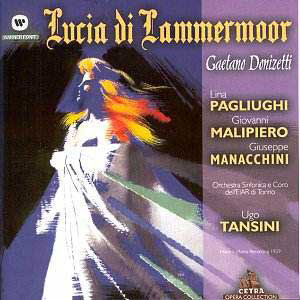Having experienced chronically shrill sound on the 1952 Cetra
Guglielmo Tell, I found the prospect of a 1939 recording from the same
source rather daunting. The weedy, wavery sound of the opening orchestral
bars seemed to bear me out, but in fact the voices are recorded firmly
and clearly, very much forward in the Cetra manner but not strident, and
the odd patch of wow is not as disturbing as the beginning had led me
to fear. All things considered this is about as good as Iíve heard from
a set of that date.
The "they-donít-sing-like-they-used-to-any-more"
brigade might usefully be obliged to listen to the Enrico and the Edgardo
here, not so much for delectation as in the same spirit with which one
rubs a puppyís nose in its mess to teach it better manners. They have
sound, well-produced voices, I grant them that, but they go through
the recitatives with the expressiveness of a blacksmith and apparently
no awareness of what they are singing about (strange, when they are
singing in their mother tongue), precious little legato and, in the
case of Manacchini, no inherent musicality in the voice. The tenor,
Giovanni Malipiero (1906-1970), does make a pleasanter sound and at
the end manages "Tu che a Dio spiegasti" with some style and
even some piano. He was actually quite a popular artist in the 1930s
and 1940s. Even so itís all pretty wooden and Iíd like to think that,
whatever our faults today, we donít sing like that any more.
The reasons for buying this set are two (or three:
the orchestra is a fine body): the conductor and the soprano. Ugo Tansini
(1874-1944) had been one of the principal conductors of the orchestra
of the EIAR (the predecessor of the present-day RAI) since 1925. He
had played under Toscanini and shapes the faster music with much of
that masterís brilliance, and above all with a lithe touch which never
lets the music become merely rowdy. The slower melodies are well-shaped
without falling into sentimentality, keeping the accompanying figures
rhythmically trim and fully alive. He never mistakes Donizettiís gentler
swing for Verdian "slancio". At a time long before the current
Donizetti revival was dreamed of, at least one Italian conductor got
it all right (he makes the traditional cuts, though).
Lina Pagliughi (1908-1980) was born in New York of
Italian parents (donít think Iím copying all this out of the booklet:
it only contains a brief description of the opera and a synopsis in
English and Italian, plus the Italian libretto). She came to Italy to
complete her studies and remained there, making her debut in Rigoletto
in Milan in 1928. She appeared at Covent Garden in Rigoletto in 1938
and continued to sing until at least 1959, but she was apparently a
whale of a woman, so much so as to prejudice her chances in the theatre
even in the days before fattism was much of an issue. The theatreís
loss was radioís gain, for she was a regular choice of the RAI in the
post-war years when a light soprano was needed, amazing visitors to
the studios with the delicate, bird-like sounds that came out of her
handsome frame.
This is what you might call a pre-Callas Lucia, with
a bright but sweet, almost girlish timbre, pure and effortless right
to the top notes, clear and accurate in coloratura. While she is not
inexpressive, especially in comparison with the other lead singers,
her voice is not a vessel for emotive force as Callasís was. Listen
to her sing "Il pallore, funesto, orrendo" (Disc 1, track
13, just after the beginning). If you didnít know the opera, and if
you didnít have the words in front of you, would you honestly know if
she was singing about something happy or something sad? Callas leaves
you in no doubt.
The other thing which makes her sound a singer of yesteryear
is her vowel-sounds. Here the aria to try is "Soffriva nel pianto"
(Disc 1, track 14). The "I"s very definitely rhyme with "tree",
the "E" are like the "E" in "get", the
"A"s like the "aa" in "baa-lamb", and
the "O"s are anything but round. This produces the very brilliant,
almost schoolgirlish voice production we often associate with pre-Callas
sopranos. Listen to the same passage from Callas and you will hear the
vowels rounded out with a touch of "O" in all of them, producing
a warmer, more liquid sound. That there were two schools of thought
even in 1939 is shown by the Raimondo on these discs. Near the beginning
of the second CD he announces, not "un fiero evento" but "on
fioro ovonto". Throughout his following aria he appears to have
a frog in his throat and, if his voice seems further away from the microphones
than the others, this is probably not because it was so but because
this style of singing shoves the voice back in the throat, making it
project far less. On the other hand, it does produce a more honeyed,
more musical sound and this aria is the one I enjoyed most of those
not sung by Pagliughi. But thereís no doubt heís gone too far in the
other direction. Callas showed that it is possible to round the vowels
without losing the voice, but then she could afford to because she had
a naturally strong, hard-hitting voice and what worked for her wonít
work for everybody. Geniuses are dangerous models.
Since this set is basically of interest for Pagliughi,
I wonder if it might not have been enough to issue a single CD based
on her contributions. Alternatively, the same performance is also on
Naxos (I havenít heard it but the transfer is well spoken-of) with the
second CD padded out with a selection of further arias from Pagliughi,
so it does sound a better buy.
Christopher Howell


![]() See
what else is on offer
See
what else is on offer 